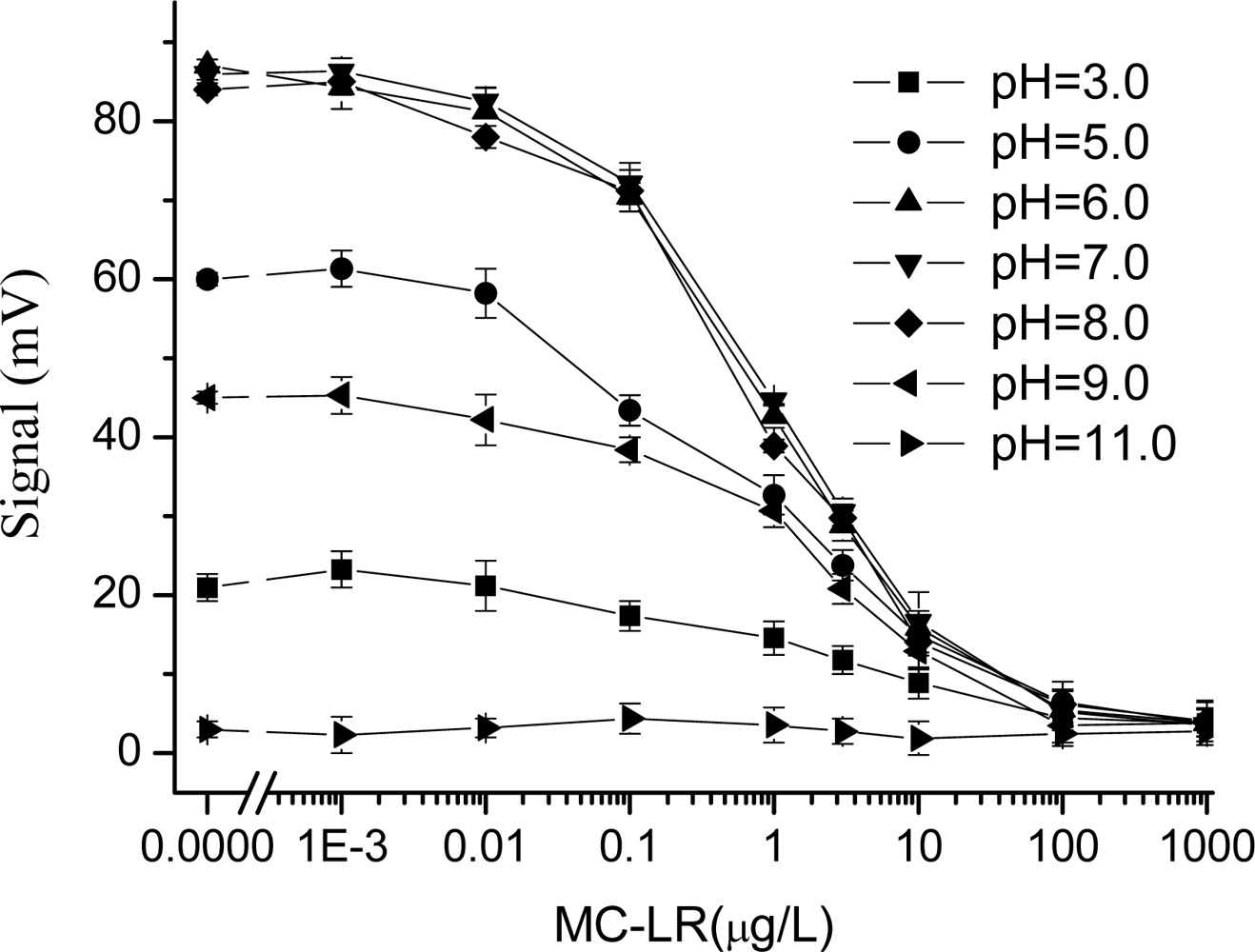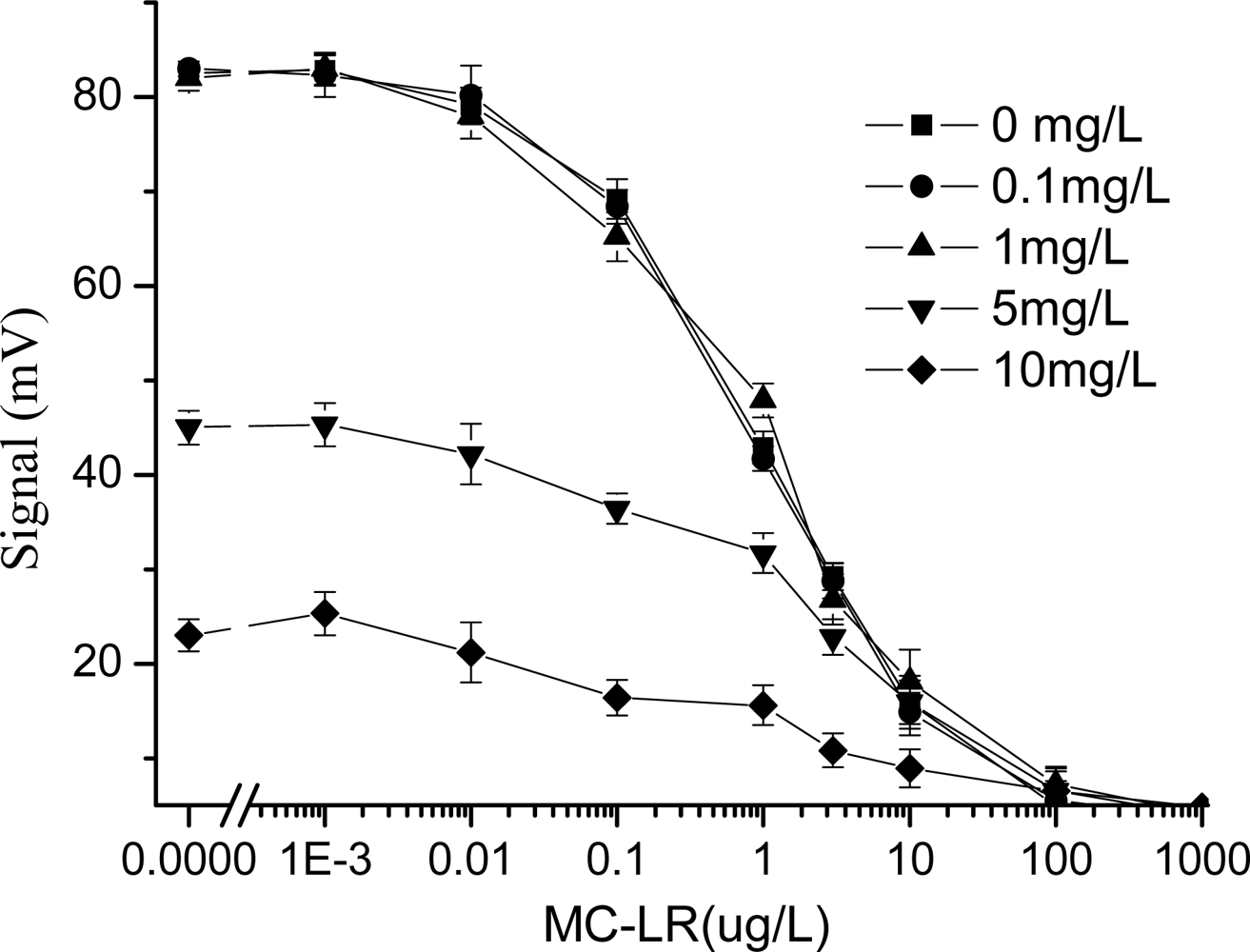Matrix Effects on the Microcystin-LR Fluorescent Immunoassay Based on Optical Biosensor
Abstract
:1. Introduction
2. Experimental
2.1. Immunoreagents and Chemicals
2.2. EWAI instrumentation
2.3. Probe preparation
2.4. Immunoassay procedure
2.5. Effect of the ionic strength
2.6. Effect of the pH
2.7. Effect of copper ion
2.8. Effect of humic acid
3. Results and Discussion
3.1. Effect of the ionic strength
3.2. Effect of the pH
3.3. Effect of copper ions and its elimination
3.4. Effect of humic acid
3.5. Water sample Analysis
4. Conclusions
Acknowledgments
References
- Rodriguez-Mozaz, S.; Reder, S.; Lopez, de Alda M.; Gauglitz, G.; Barceló, D. Simultaneous multi-analyte determination of estrone, isoproturon and atrazine in natural waters by the RIver ANAlyser (RIANA), an optical immunosensor. Biosens. Bioelectron 2004, 19, 633–640. [Google Scholar]
- Kroll, M.H.; Elin, R.J. Interference with clinical laboratory analyses. Clin. Chem 1994, 40, 1996–2005. [Google Scholar]
- WHO. Guidelines for Drinking Water Quality, third ed; World Health Organization: Geneva, Switzerland, 2003. [Google Scholar]
- Jochimsen, E.M.; Carmichael, W.W.; An, J.S.; Cardo, D.M.; Cookson, S.T.; Holmes, C.E.; Antunes, M.B.; Melo Filho, D.A.; Lyra, T.M.; Barreto, V.S.; Azevedo, S.M.; Jarvis, W.R. Liver Failure and Death after Exposure to Microcystins at a Hemodialysis Center in Brazil. N. Engl. J. Med 1998, 338, 873–878. [Google Scholar]
- Carmichael, W.W.; Azevedo, S.M.; An, J.S.; Molica, R.J.; Jochimsen, E.M.; Lau, S.; Rinehart, K.L.; Shaw, G.R.; Eaglesham, G.K. Human Fatalities from Cyanobacteria: Chemical and Biological Evidence for Cyanotoxins. Environ. Health Perspect 2001, 109, 663–668. [Google Scholar]
- Hastie, C.J.; Borthwick, E.B.; Morrison, L.F.; Codd, G.A.; Cohen, P.T.W. Inhibition of several protein phosphatases by a non-covalently interacting microcystin and a novel cyanobacterial peptide, nostocyclin. Biochim. Biophys. Acta 2005, 1726, 187–193. [Google Scholar]
- Lindner, P.; Molz, R.; Yacoub-George, E.; Dürkop, A.; Wolf, H. Development of a highly sensitive inhibition immunoassay for microcystin-LR. Anal. Chim. Acta 2004, 521, 37–44. [Google Scholar]
- Campàs, M.; Marty, J. Highly sensitive amperometric immunosensors for microcystin detection in algae. Biosens. Bioelectron 2007, 22, 1034–1040. [Google Scholar]
- González-Martínez, M.A.; Puchades, R.; Maquieira, A. Optical immunosensors for environmental monitoring: How far have we come. Anal. Bioanal. Chem 2007, 387, 205–214. [Google Scholar]
- Shriver-lake, L.C.; Breslin, K.A.; Charles, P.T.; Conrad, D.W.; Ligler, F.S. Detection of TNT in Water Using an Evanescent Wave Fiber Optic Biosensor. Anal. Chem 1995, 67, 2431–2435. [Google Scholar]
- Thompson, V.S.; Maragos, C.M. Fiber-optic immunosensor for the detection of fumonisin B1. J. Agric. Food Chem 1996, 44, 1041–1046. [Google Scholar]
- Willer, U.; Scheel, D.; Kostjucentko, I.; Bohling, C.; Schade, W.; Faber, E. Fiber-optic evanescent-field laser sensor for in-situ gas diagnostics. Spectrochim. Acta, A 2002, 58, 2427–2442. [Google Scholar]
- Long, F.; Shi, H.C.; He, M.; Zhu, A.N. Development of evanescent wave all-fiber immunosensor for environmental water analysis. Biosens. Bioelectron 2008, 23, 952–958. [Google Scholar]
- Long, F.; Shi, H.C.; He, M.; Zhu, A.N. Sensitive and rapid detection of 2,4-dicholorophenoxyacetic acid in water samples by using evanescent wave all-fiber immunosensor. Biosens. Bioelectron 2008, 23, 1361–1366. [Google Scholar]
- Bhatia, S.K.; Shrive-Lake, L.C.; Prior, K.J.; Georger, J.H.; Calvert, J.M.; Bredehorst, R.; Ligler, F.S. Use of thiol-terminal silanes and heterobifunctional crosslinkers for immobilization of antibodies on silica surfaces. Anal. Biochem 1989, 178, 408–413. [Google Scholar]
- AWWARF 267, Request for Proposals: Alternative (i.e. non-copper) algae control strategies. http://www.bv.com/resources/water_brochures/rsrc_researchBrochure.pdf.
- Oubiña, A.; Barceló, D.; Marco, M.P. Effect of competitor design on immunoassay specificity: Development and evaluation of an enzyme-linked immunosorbent assay for 2,4-dinitrophenol. Anal. Chim. Acta 1999, 387, 267–279. [Google Scholar]
- Oubiña, A.; Gascón, J.; Barceló, D. Multianalyte effect in the determination of cross-reactivities of pesticide immunoassays in water matrices. Anal. Chim. Acta 1999, 387, 121–130. [Google Scholar]
- Gascón, J.; Oubiña, A.; Onnerjord, P.; Ferrer, I.; Hammock, B.D.; Barceló, D. Performance of two immunoassays for the determination of atrazine in sea water samples as compared with on-line solid phase extraction-liquid chromatography-diode array detection. Anal. Chim. Acta 1996, 330, 41–51. [Google Scholar]
- Ballesteros, B.; Barceló, D.; Sanchez-Baeza, F.; Camps, F.; Marco, M.P. Influence of the hapten design on the development of a competitive ELISA for the determination of the antifouling agent Irgarol 1051 at trace levels. Anal. Chem 1998, 70, 4004–4014. [Google Scholar]
- Matikainen, M.T. Effect of pH on reactivity of monoclonal antibodies to Chlamydia. J. Immunol. Meth 1984, 75, 211–216. [Google Scholar]
- Castle, P.E.; Karp, D.A.; Zeitlin, L.; Garca-Moreno, B.; Moench, T.R.; Whaley, K.J.; Cone, R.A. Human monoclonal antibody stability and activity at vaginal pH. J. Reprod. Immunol 2001, 56, 61–76. [Google Scholar]
- Moore, G.T.; Kellerman, K. F. Copper as an algicide and disinfectant in water supplies. US Bur. Plant Indus. Bull 1905, 56, 55. [Google Scholar]
- Sharma, S.K.; Goloubinoff, P.; Christen, P. Heavy metal ions are potent inhibitors of protein folding. Biochem. Biophys. Res. Commun 2008, 372, 341–345. [Google Scholar]
- Bauer, R.; Muller, A.; Richter, M.; Schneider, K.; Frey, J.; Engelhardt, W. Influence of heavy metal ions on antibodies and immune complexes investigated by dynamic light scattering and enzyme-linked immunosorbent assay. Biochimica. Biophysica. Acta 1997, 1334, 98–108. [Google Scholar]
- Toscano, I.; Gascón, J.; Marco, M.P.; Rocha, J.C.; Barcel, D. Atrazine interaction with tropical humic substance by enzyme linked immunosorbent assay. Analusis 1998, 26, 130–134. [Google Scholar]





| Origin | MC-LR in water sample (μg·L−1) | MC-LR added to the samples (μg·L−1) | MC-LR by EWAI (Mean) (μg·L−1) | CV (%) | Recovery (%) |
|---|---|---|---|---|---|
| Tap water | 0 | 0.5 | 0.45 | 2.1 | 90 |
| 2 | 1.98 | 3.0 | 99 | ||
| Tai Lake | 0.52 | 0.5 | 0.96 | 1.2 | 96 |
| 2 | 2.64 | 3.4 | 106 | ||
| Cao Lake | 0.31 | 0.5 | 0.83 | 1.5 | 104 |
| 2 | 2.24 | 4.2 | 96.5 |
© 2009 by the authors; licensee MDPI, Basel, Switzerland This article is an open access article distributed under the terms and conditions of the Creative Commons Attribution license (http://creativecommons.org/licenses/by/3.0/).
Share and Cite
Long, F.; Zhu, A.-n.; Sheng, J.-W.; He, M.; Shi, H.-C. Matrix Effects on the Microcystin-LR Fluorescent Immunoassay Based on Optical Biosensor. Sensors 2009, 9, 3000-3010. https://doi.org/10.3390/s90403000
Long F, Zhu A-n, Sheng J-W, He M, Shi H-C. Matrix Effects on the Microcystin-LR Fluorescent Immunoassay Based on Optical Biosensor. Sensors. 2009; 9(4):3000-3010. https://doi.org/10.3390/s90403000
Chicago/Turabian StyleLong, Feng, An-na Zhu, Jian-Wu Sheng, Miao He, and Han-Chang Shi. 2009. "Matrix Effects on the Microcystin-LR Fluorescent Immunoassay Based on Optical Biosensor" Sensors 9, no. 4: 3000-3010. https://doi.org/10.3390/s90403000
APA StyleLong, F., Zhu, A.-n., Sheng, J.-W., He, M., & Shi, H.-C. (2009). Matrix Effects on the Microcystin-LR Fluorescent Immunoassay Based on Optical Biosensor. Sensors, 9(4), 3000-3010. https://doi.org/10.3390/s90403000




